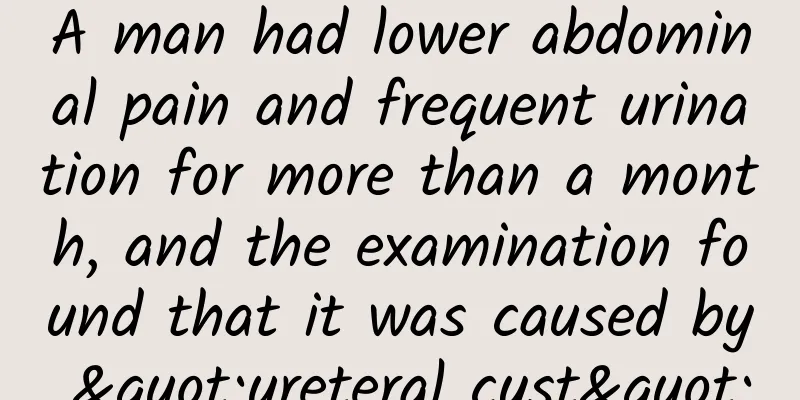A man had lower abdominal pain and frequent urination for more than a month, and the examination found that it was caused by "ureteral cyst"

|
Recently, a 44-year-old middle-aged man went to the Urology Department of Hunan Hospital of Integrated Traditional Chinese and Western Medicine (Affiliated Hospital of Hunan Institute of Traditional Chinese Medicine) for treatment due to lower abdominal distension and pain accompanied by frequent urination for more than a month. After receiving the consultation, Chief Physician Yang Jian arranged for the patient to undergo a color Doppler ultrasound examination of the urinary system and initially diagnosed him with ureteral cyst. After the patient was admitted to the hospital, he was diagnosed with ureteral cyst and multiple stones in the affected kidney after urinary tract CT and cystoscopy. After further examinations, the urology team performed transurethral ureterocele electroresection and decompression + transurethral ureteroscopy lithotripsy under general anesthesia. After the operation, the patient's condition improved and he was discharged smoothly. 1. What is a ureterocele? According to Dr. Liu Jian from the Urology Department , ureterocele is a cystic dilation of the end of the ureter under the mucosa of the bladder. The cyst has a bladder mucosa on the outer layer, a thin layer of muscle tissue in the middle, and a ureteral mucosa on the inner layer. In layman's terms, it is like the ureteral opening is blown up like a "balloon." Ureterocyst is a genetic disease, more common in children, with a higher incidence in women, and less common in adults. The cause and pathogenesis of ureterocele have not yet been confirmed, but it is generally believed that the ureter is not fully developed during the embryonic period. 2. What are the categories of ureterocele? Ureteroceles can be clinically divided into the following four categories. Category I: Ureteroceles in situ or simple cysts, more common in adult males, with normal ureteral openings, the cysts are completely located in the bladder, larger cysts cause obstruction, and combined with stones; Category II: Ectopic ureterocele, common in children; Category III: Ureterocystic prolapse, which refers to an ectopic ureterocele protruding from the urethral opening through the bladder neck and urethra. This disease is more common in women. Category 4: Blind ureteral cyst, which refers to the absence of the terminal opening of the ureter, causing a ureteral cyst in the trigone of the bladder. 3. What are the clinical manifestations of ureterocele? The main symptoms of ureterocele are urinary tract obstruction and recurrent urinary tract infection. Other symptoms include urination disorder, urine flow interruption, hematuria, and concurrent stones. The diagnosis of this disease is often discovered when repeated abnormal kidney symptoms appear. If the disease is allowed to develop, it will lead to the occurrence of uremia due to long-term urinary tract infection and (or) obstruction. Some types of ureterocele will seriously affect the quality of life. 4. How to diagnose ureterocele? In addition to the above clinical manifestations, the diagnosis of ureterocele is mainly based on B-ultrasound examination, urethroscopy, cystoscopy and urography. Figure 1 is an image of ureterocele examined by cystoscopy during surgery, showing that the ureteral opening is obviously bulging. (Figure 1) 5. How to treat ureterocele? Surgery is an effective method for treating ureterocele. The principle of treatment is to relieve obstruction, prevent reflux and deal with complications. For different types of cyst surgery, minimally invasive endoscopic surgery is basically used. Transurethral ureterocele electroresection or cystoscopic cyst incision is often used. This surgical method is often suitable for adults. For children, it is advisable to open the bladder and expose the ureterocele and perform cystoplasty, while larger cysts should be treated with cystectomy. Generally, after surgery, the patient's symptoms and ureteral dilatation and hydronephrosis will be significantly improved. Experts advise Chief Physician Yang Jian from the Department of Urology kindly reminds the public: 1. Drink more water in daily life. It is recommended to drink 2500ml-3000ml of water. Do not hold urine. 2. You can use traditional Chinese medicine combined with TCM meridian acupoints for rehabilitation therapy to promote urine excretion and relieve low back pain symptoms. If necessary, take oral antibiotics to prevent infection; 3. This disease is relatively rare. If it is discovered during a physical examination or the above-mentioned typical clinical symptoms appear, seek medical attention promptly. Those who need surgery do not need to be nervous. Minimally invasive surgery has little impact on the body and can not only help you recover quickly, but also relieve your worries and problems. Hunan Medical Chat Special Author: Liu Jian, Department of Urology, Hunan Hospital of Integrated Traditional Chinese and Western Medicine (Affiliated Hospital of Hunan Institute of Traditional Chinese Medicine) Follow @湖南医聊 to get more health science information! (Edited by YT) |
<<: World Down Syndrome Day: From science to care, the truth we need to know
Recommend
What medicine is good for women who have frequent nocturia?
Frequent urination at night should be experienced...
Acupuncture points for female beauty care
In fact, whether a person's body is healthy o...
Can uterine coldness cause abdominal obesity?
If you female friends find that you have abdomina...
How can women remove freckles through internal adjustment?
Compared with men, women are more prone to endocr...
What is the correct sleeping position for early pregnant women?
Pregnant women should pay attention to their phys...
Precautions for pregnant women with uterine fibroids
Uterine fibroids are a common disease that occurs...
eMarketer: Second screen usage growth in 2018 mainly comes from smartphones
199IT original compilation While watching TV, the...
What to do if there is no cooking wine for pickled hairtail fish? What to use instead of cooking wine for pickled hairtail fish?
We all know that hairtail is a common fish food. ...
How many days of delayed menstruation is normal?
Nowadays, delayed menstruation has become a conce...
What are the external medicines for pelvic inflammatory disease
In fact, there are relatively few women suffering...
The body is asleep, but the legs are "awake"? No wonder people with this problem can't sleep well!
There are many reasons why you can't sleep An...
What causes vaginal odor after sex?
In daily life, gynecological diseases are a very ...
What to do if your period is not on time
Menstruation is a natural phenomenon that every w...
33 weeks of pregnancy, sudden and no obvious fetal movement
During the second trimester, pregnant mothers oft...
What are the benefits of drinking red wine regularly for women?
Red wine is a common type of alcoholic beverage. ...









